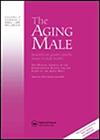男性雄激素受体CAG重复序列的数量与死亡率
IF 2.7
4区 医学
Q3 ENDOCRINOLOGY & METABOLISM
引用次数: 3
摘要
摘要引言雄激素受体(AR)介导睾酮的外周效应。有证据表明,AR基因外显子1中CAG重复序列的数量与AR转录活性呈负相关。该分析的目的是确定男性CAG重复数与死亡率之间的关系。方法40-79岁男性 2003年至2005年间,从初级保健机构招募了几岁的人参加欧洲男性老龄化研究的英国分部。Cox比例风险模型用于确定CAG重复次数/死亡率之间的相关性。结果表示为危险比(HR)/95%置信区间(CI)。结果随访312例。平均基线年龄为59.5岁 年。随访时,85/312(27%)男性死亡。CAG重复序列长度为14-39,其中21个重复序列的CAG重复数比例最高(16.4%)。在一个多变量模型中,以CAG重复次数为22-23的男性为参考,CAG重复数量较低的男性(23)(1.37(0.65,2.91))。还需要进行更大规模的研究来量化这种影响。本文章由计算机程序翻译,如有差异,请以英文原文为准。
The number of androgen receptor CAG repeats and mortality in men
Abstract Introduction The androgen receptor (AR) mediates peripheral effects of testosterone. Evidence suggests that the number of CAG repeats in exon-1 of the AR gene negatively correlates with AR transcriptional activity. The aim of this analysis was to determine the association between CAG repeat number and mortality in men. Methods Men aged 40–79 years were recruited from primary care for participation in the UK arm of the European Male Aging Study between 2003 and 2005. Cox proportional hazards modelling was used to determine the association between CAG repeat number/mortality. Results were expressed as hazard ratios(HR)/95% confidence intervals (CI). Results 312 men were followed up. The mean baseline age was 59.5 years. At follow up, 85/312(27%) men had died. CAG repeat length ranged from 14 to 39, with the highest proportion of CAG repeat number at 21 repeats(16.4%). In a multivariable model, using men with CAG repeat numbers of 22-23 as the reference, men with a lower number of CAG repeats(<22) showed a trend for a higher mortality in the follow-up period (HR 1.46 (0.75, 2.81)) as did men with higher number of repeats (>23) (1.37 (0.65, 2.91)). Conclusion Our data suggest that CAG repeat number may partially influence the risk of mortality in men. Further larger studies are required to quantify the effect.
求助全文
通过发布文献求助,成功后即可免费获取论文全文。
去求助
来源期刊

Aging Male
医学-泌尿学与肾脏学
CiteScore
6.40
自引率
3.80%
发文量
33
审稿时长
>12 weeks
期刊介绍:
The Aging Male , the official journal of the International Society for the Study of the Aging Male, is a multidisciplinary publication covering all aspects of male health throughout the aging process. The Journal is a well-recognized and respected resource for anyone interested in keeping up to date with developments in this field. It is published quarterly in one volume per year.
The Journal publishes original peer-reviewed research papers as well as review papers and other appropriate educational material that provide researchers with an integrated perspective on this new, emerging specialty. Areas of interest include, but are not limited to:
Diagnosis and treatment of late-onset hypogonadism
Metabolic syndrome and related conditions
Treatment of erectile dysfunction and related disorders
Prostate cancer and benign prostate hyperplasia.
 求助内容:
求助内容: 应助结果提醒方式:
应助结果提醒方式:


